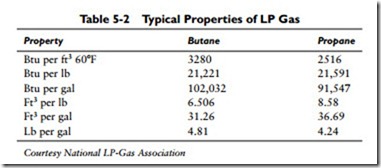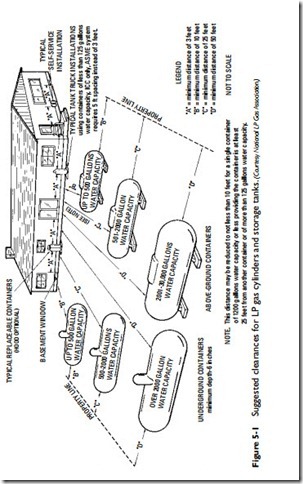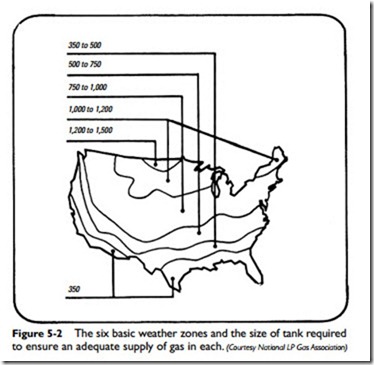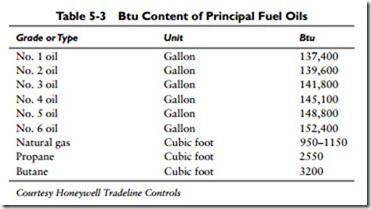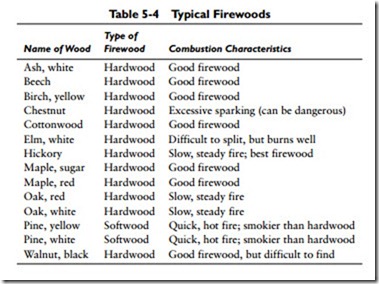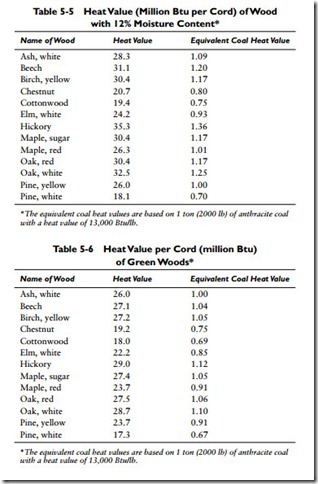Liquefied Petroleum Gas
Liquefied petroleum (LP) gas is a hydrocarbon mixture extracted primarily from wet natural gas and sold commercially as propane, butane, bottled gas, or under a variety of different brand names. The terms dry and wet natural gas refer to the gasoline content per 1000 ft3. Natural gas is regarded as dry if it contains less than 0.1 gallon of gasoline per 1000 ft3. and wet if it contains more than 0.1 gallon.
Propane is used extensively for domestic heating purposes. It contains 2516 Btu/ft3 (91,547 Btu per gallon), or about two and a half times the Btu content of methane (natural gas). Table 5-2 compares the typical properties of propane and butane. Unlike natural gas, propane is heavier than air. An undetected leak can be quite dangerous because the escaping gas will accumulate in layers at floor level. An explosion can be set off if the gas reaches the level of the pilot flame in the furnace.
Propane is frequently delivered in bulk and stored in large, stationary tanks holding from 100 to 1000 gallons. It is then piped into the home or building in much the same manner as natural gas. For small usage (e.g., trailers or homes that use only enough gas for one or two appliances), the LP gas is delivered to 5- to 25-gallon cylinders. The suggested clearances for LP gas cylinders and storage tanks are shown in Figure 5-1. The size of the storage tank required by an installation depends upon the weather zone in which it is located. Recommend tank sizes for the various weather zones in the United States are given in Figure 5-2.
Fuel Oils
Fuel oils are hydrocarbon mixtures obtained from crude petroleum by refining processes. They may be divided in the following six classes or grades:
1. No. 1 fuel oil for vaporizing pot-type and other burners designed for this fuel
2. No. 2 fuel oil for general-purpose domestic heating not re- quiring a lighter No. 1 oil
3. No. 3 fuel oil (obsolete since 1948)
4. No. 4 fuel oil for installations not equipped for preheating
5. No. 5 fuel oil for installations equipped for preheating
6. No. 6 fuel oil for burner installations equipped for preheating with a high-viscosity fuel This classification of fuel oils is based on several characteristics, including: (1) viscosity, (2) flash point, (3) pour point, (4) ash con- tent, (5) carbon residues, and (6) water and sediment content. All
these characteristics are important to consider when selecting a fuel oil. For example, the water content will determine its suitability for outdoor storage. A low viscosity indicates a fuel oil with good flow characteristics.
No. 1 fuel oil has the lowest viscosity (1.4–2.2). This is a distillate oil used in atomizing and similar burners because it can be easily broken down into small droplets.
No. 2 fuel oil is a distillate oil used in domestic oil burners that do not require preheating. It is slightly heavier than a No. 1 fuel oil. No. 4 fuel oil is slightly heavier than No. 2 and will work in some oil burners without preheating.
No. 2 and No. 4 fuel oils contain the highest ash content (0.10 to 0.50 percent by weight, respectively). The other grades contain lit- tle or no ash. Although slagging (i.e., the formation of noncom- bustible deposits) is commonly associated with solid fuels such as
coal, this problem also occurs in oil-burning equipment (see Ash, Slag, and Clinker Formation later in this chapter).
No. 5 and No. 6 (or Bunker C) fuel oils are heavier than the other grades and require preheating. In automatically operated oil burners, the preheating of the fuel oil must be completed before it is delivered for combustion. When the fuel oil has reached a suitable atomizing temperature, the preheating is considered completed.
PS 300 and PS 400 are heating oils used on the West Coast. They roughly correspond to No. 5 and No. 6 fuel oils, respectively. PS 300 is the lighter of the two and is used primarily for domestic heating purposes. PS 400 is heavier, requires preheating, and is used for industrial purposes.
The grade of fuel oil to be used in an oil burner is specified by the manufacturer. This should also be stipulated on the label of the Underwriters Laboratories, Inc. (UL), and Underwriters’ Lab- oratories of Canada. Table 5-3 compares the Btu content of the principal fuel oils.
Coal
Coal is a solid fuel created from deposits of ancient vegetation that have undergone a series of metamorphic changes resulting from pressure, heat, submersion, and other natural formative processes occurring over a long period of time. Because of the different com- binations of these processes acting on the vegetation and the widely differing forms of vegetation involved, coal is a complex and nonuniform substance.
Coal is often classified according to the degree of metamorphic change to which it has been subjected into the following categories:
1. Anthracite
2. Bituminous coal
3. Semibituminous coal
4. Lignite
The formation of peat represents a precoal stage of development. After increased pressure and time, lignite begins to form. The next stage is semibituminous coal, followed by bituminous coal and finally anthracite. Each of these stages is characterized by an in- crease in the hardness of the coal. Anthracite is the hardest of the coals. Graphite represents a postcoal developmental stage and can- not be used for heating purposes.
Anthracite is clean, hard coal that burns with little or no luminous flame or smoke. It is difficult to ignite but burns with a uniform, low flame once the fire is started. Anthracite contains approximately 14,400 Btu/lb and is used for both domestic and industrial heating purposes. Its major disadvantage as a heating fuel is its cost.
Anthracite is divided by size into several different grades. Each of these grades (e.g., egg size, buckwheat size, pea size) is suitable for a specific size of firepot. They are described in greater detail in Chapter 3 of Volume 2 (“Coal-Firing Methods”).
Bituminous coal is softer than anthracite and burns with a smoky, yellow flame. A great amount of smoke will result if it is improperly fired. The term bituminous coal actually covers a whole range of coals, many of which have widely differing combustion characteristics. Some of the coals belonging to this classification are hard, whereas others are soft.
The available heat for bituminous coal ranges from a low of 11,000 Btu/lb (Indiana bituminous) to a high of 14,100 Btu/lb (Pocahontas bituminous). The heat value of the latter approximates that of anthracite (about 14,400 Btu/lb); however, unlike anthracite coal, it is available in far greater supply, a factor that makes it a very economical solid fuel to use.
Semibituminous coal is a soft coal that ignites slowly and burns with a medium-length flame. Because it provides so little smoke, it is sometimes referred to as smokeless coal.
Lignite (sometime referred to as brown coal) ignites slowly, pro- duces very little smoke, and contains a high degree of moisture. In structure it is midway between peat and bituminous coal. Lignite contains approximately half the available heat of anthracite (or about 7400 Btu/lb) and burns with a long flame. Its fire is almost smokeless, and it does not coke, a characteristic it shares with anthracite.
Lignite is considered a low-grade fuel, and its caloric value is low when compared with the other coals. Moreover, it is difficult to handle and store.
Coke
Coke is the infusible, solid residue remaining after the distillation of certain bituminous coal or as a by-product of petroleum distillation. Coke may also be obtained from petroleum residue, pitch, and other materials representing the residue of destructive distillation.
Coke will ignite more quickly than anthracite but less readily than bituminous coal. It burns rapidly with little draft. As a result, all openings or leaks into the ash pit must be closed tightly when coke is being burned.
Since less coke is burned per hour per square foot of grate than coal, a larger grate is required and a deep firepot is necessary to accommodate the thick bed of coal. Since coke contains very little hydrogen, the quick-flaming combustion that characterizes coal is not produced, but the fire is nearer even and regular.
The best size of coke recommended for general use, for small firepots where the fuel depth is not over 20 in, is that which passes over a 1-in screen and through a 11⁄2-in screen. For large firepots where the fuel can be fired over 20 in deep, coke that passes over a 1-in screen and through a 3-in screen can be used, but a coke of uniform size is always more satisfactory.
Briquettes
Briquettes are a solid fuel prepared from coal dust and fines (i.e., finely crushed or powdered coal) by adding a binder and holding it under pressure.
The binder is commonly pitch or coal tar, but other substances and materials are also used. A briquette made with a pitch binder has the highest caloric value, exceeding that of any coal. The ash content is generally less than that of coal. Briquettes have been made from lignite coal dust and fines without a binder (only pressure being used).
Coal Oil
Coal oil is a heating fuel formerly derived from coal tar. Formerly it enjoyed widespread use, but it is has now been largely replaced by petroleum-based products. It is also called paraffin oil or kerosene.
Today, kerosene is obtained from petroleum through a refining process.
Wood as Fuel
A good, well-seasoned hardwood will provide approximately half as much heat value per pound as does good coal (Table 5-4). Wood is easy to ignite, burns with little smoke, and leaves comparatively little ash. On the other hand, it requires a larger storage space (commonly outdoors), and more labor is involved in its preparation.
Wood is commonly sold by the cord for heating purposes. A standard cord measures 4 ft high by 8 ft wide and contains wood cut to 4-ft lengths for a total of 128 ft3. Only about 70 percent of a standard cord actually represents the wood content, however, because of the existence of air spaces between the wood.
The heat value of wood depends upon the type of wood being burned. Heat values per cord for a number of different types of wood are given in Tables 5-5 and 5-6. The data used to com- pile the tables were obtained from Use of Wood for Fuel (U.S. Department of Agriculture Bulletin No. 753). The wood heat
values are determined for cords containing approximately 90 cu ft of solid wood (i.e., about 70 percent of a standard cord). Note that the heat values for both green and dry wood (12 percent moisture content) are given in Tables 5-5 and 5-6. It is important to remember that the amount of moisture in a wood will affect its burning characteristics. A green wood will burn much more slowly than a drier one, and its fire will be more difficult to start.
All wood can be divided into either hardwood or softwood. Contrary to popular belief, the basic difference between the two groups is not the hardness of the wood. In other words, a wood that can be classified as a softwood is not necessarily softer than a hardwood. These terms do not refer to the physical properties of the wood but to its classification as a coniferous (needle or cone-bearing) or deciduous (broad-leafed) tree. A softwood comes from a coniferous tree, whereas a hardwood is obtained from a deciduous tree. You will find that some softwood trees produce wood that is harder than the wood obtained from some hardwood trees.
Chimney or flue fires are always a hazard when wood is used as a heating fuel. Resins and soot collect in these areas over time and can be ignited if there is a flare up of the fire. The possibility of this happening can be eliminated or greatly reduced by cleaning the chimney or flue from time to time.
Softwoods (e.g., white or yellow pine) contain greater amounts of resin than do hardwoods. This tends to give softwoods flammability, but it also results in more smoke.
